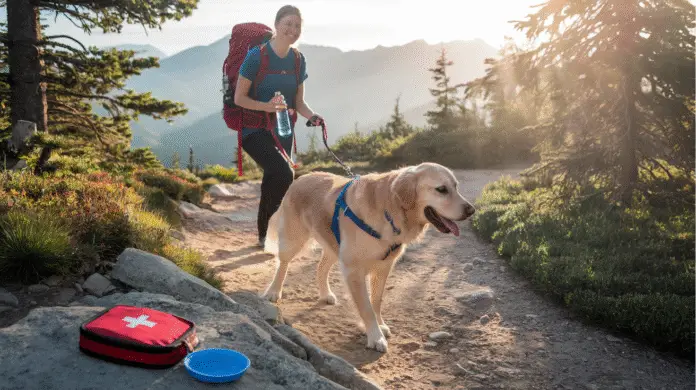
🐾 Imagine the perfect hiking adventure: crisp mountain air, scenic trails, and your four-legged best friend by your side. But before you hit the trail with your canine companion, it’s crucial to ensure you’re prepared for a safe and enjoyable experience. Many hikers overlook the unique challenges of bringing their dogs along, potentially putting both themselves and their pets at risk.
Are you ready to embark on an unforgettable journey with your furry friend? From essential gear to trail etiquette, this guide will equip you with everything you need to know for a successful hike with your dog. We’ll cover pre-hike preparations, on-trail safety measures, and even post-hike care to keep your pup happy and healthy. So, lace up your boots, grab that leash, and let’s explore the world of dog-friendly hiking together!
Essential Gear for Dog-Friendly Hiking

Choosing the right leash and harness
When hiking with your furry friend, selecting the appropriate leash and harness is crucial for both safety and comfort. A sturdy, hands-free leash allows you to maintain control while keeping your hands free for balance or using trekking poles. Look for leashes with shock-absorbing features to reduce strain on both you and your dog.
For harnesses, opt for a well-fitted, padded design that distributes pressure evenly across your dog’s chest and shoulders. Avoid neck collars, which can cause strain during long hikes.
| Leash Type | Pros | Cons |
|---|---|---|
| Hands-free | Allows freedom of movement | May not provide as much control |
| Standard 6-foot | Offers good control | Requires constant hand holding |
| Retractable | Adjustable length | Can be dangerous on trails |
Water and portable bowls
Staying hydrated is essential for both you and your canine companion. Pack enough water for both of you, plus extra for emergencies. Collapsible bowls are lightweight and easy to carry, making them perfect for trail breaks.
First-aid kit essentials for dogs
A well-stocked first-aid kit is a must-have for any hiking adventure. Include:
- Gauze pads and self-adhesive bandages
- Tweezers for removing ticks or splinters
- Antiseptic wipes
- Canine-safe antihistamines
- Disposable gloves
- Emergency blanket
Protective booties and paw balm
Rough terrain can be tough on your dog’s paws. Protective booties provide an extra layer of defense against sharp rocks, hot surfaces, and potential injuries. If your dog isn’t comfortable with booties, pack paw balm to soothe and protect their paw pads during and after the hike.
Now that we’ve covered the essential gear, let’s move on to pre-hike preparations to ensure a safe and enjoyable experience for both you and your four-legged hiking buddy.
Pre-Hike Preparations

Health check and vaccinations
Before hitting the trails with your furry friend, it’s crucial to ensure they’re in top shape. Schedule a vet visit to:
- Update vaccinations
- Check for parasites
- Assess overall fitness
| Vaccination | Importance for Hiking |
|---|---|
| Rabies | Protection from wildlife |
| Leptospirosis | Guards against bacteria in water sources |
| Bordetella | Prevents kennel cough from other dogs |
Physical conditioning for your dog
Just like humans, dogs need to build stamina for hiking. Start with:
- Daily walks, gradually increasing distance
- Short, easy hikes to build endurance
- Swimming for low-impact exercise
- Agility training to improve balance and coordination
Trail selection based on dog’s abilities
Choose trails that match your dog’s fitness level and age. Consider:
- Trail difficulty and length
- Terrain type (rocky, smooth, steep)
- Availability of water sources
- Potential wildlife encounters
Packing appropriate food and treats
Proper nutrition is key to a successful hike. Pack:
- High-energy, easily digestible dog food
- Nutrient-dense treats for quick boosts
- Plenty of water (1 ounce per pound of body weight)
Remember to bring collapsible bowls for easy feeding and hydration breaks.
Now that you’ve prepared your furry companion for the adventure, let’s explore the essential safety measures to follow while on the trail.
On-Trail Safety Measures

A. Keeping your dog leashed and controlled
When hiking with your furry companion, keeping them leashed and under control is crucial for their safety and the safety of others. Use a sturdy, comfortable leash that allows for easy maneuvering on the trail. Consider these leash options:
| Leash Type | Pros | Cons |
|---|---|---|
| Standard 6-foot | Good control, versatile | May be too short for some trails |
| Retractable | Allows more freedom | Less control, can tangle easily |
| Hands-free belt | Keeps hands free for balance | May not provide immediate control |
Always maintain awareness of your surroundings and keep your dog close when passing other hikers or wildlife.
B. Proper hydration techniques
Ensuring your dog stays hydrated is essential for a safe and enjoyable hike. Follow these tips:
- Bring plenty of fresh water for both you and your dog
- Offer water frequently, especially during warm weather
- Use a collapsible bowl for easy drinking
- Consider a dog-specific hydration pack for longer hikes
C. Regular rest and cooldown stops
Taking breaks is crucial for your dog’s well-being. Schedule regular stops to:
- Allow your dog to rest and cool down
- Check for signs of fatigue or overheating
- Offer water and small snacks
- Inspect paws for injuries or debris
D. Dealing with wildlife encounters
Wildlife encounters can be dangerous for both you and your dog. Stay prepared by:
- Keeping your dog leashed to prevent chasing wildlife
- Making noise to alert animals of your presence
- Carrying bear spray in bear country
- Knowing how to react to different types of wildlife (e.g., bears, snakes, mountain lions)
E. Navigating challenging terrain
Help your dog safely traverse difficult trails by:
- Assisting them over large obstacles
- Using a harness with a handle for lifting if needed
- Avoiding terrain that’s too challenging for your dog’s abilities
- Watching for sharp rocks or other hazards that could injure paws
Now that we’ve covered on-trail safety measures, let’s explore how to recognize and prevent heat-related issues, which can be a significant concern when hiking with dogs.
Recognizing and Preventing Heat-Related Issues

Signs of heat exhaustion in dogs
Recognizing heat exhaustion in your canine companion is crucial for their safety on the trail. Watch for these key indicators:
- Excessive panting or drooling
- Lethargy or weakness
- Stumbling or disorientation
- Vomiting or diarrhea
- Bright red or pale gums
If you notice any of these signs, take immediate action to cool your dog down and seek veterinary care if symptoms persist.
Cooling techniques on the trail
When your dog shows signs of overheating, employ these cooling methods:
- Find shade immediately
- Offer small amounts of cool water
- Wet your dog’s paws and belly
- Use a cooling vest or bandana
- Take frequent rest breaks
| Cooling Method | Effectiveness | Ease of Use |
|---|---|---|
| Shade | High | Easy |
| Water | High | Easy |
| Wetting dog | Medium | Moderate |
| Cooling gear | High | Easy |
| Rest breaks | Medium | Easy |
Choosing optimal hiking times
To prevent heat-related issues, plan your hikes during cooler parts of the day:
- Early morning: Best option for summer hikes
- Late evening: Good alternative if mornings aren’t possible
- Overcast days: Ideal for longer hikes
Avoid midday hikes, especially during hot summer months. Always check the weather forecast and trail conditions before setting out. With these precautions in mind, let’s explore proper trail etiquette when hiking with your furry friend.
Trail Etiquette with Dogs

Respecting other hikers and their pets
When hiking with your furry companion, it’s crucial to be mindful of other trail users. Always keep your dog on a leash unless in designated off-leash areas. This ensures the safety of your pet and prevents unwanted interactions with other hikers or wildlife. When approaching other hikers or dogs, maintain control of your pet and ask for permission before allowing them to interact.
| Etiquette Tips | Reasons |
|---|---|
| Use a leash | Safety and control |
| Step aside for others | Show courtesy |
| Ask before interactions | Respect boundaries |
| Keep noise levels down | Preserve trail atmosphere |
Managing waste responsibly
As a responsible dog owner, it’s your duty to clean up after your pet. Always carry waste bags and dispose of them properly. Some trails may have designated waste bins, but if not, pack it out with you. This practice helps maintain the trail’s cleanliness and prevents the spread of disease.
- Bring extra waste bags
- Use biodegradable bags when possible
- Pack out all waste, including used bags
- Never leave waste bags on the trail, even if you plan to pick them up later
Following local regulations and guidelines
Different trails and parks may have specific rules regarding dogs. Before embarking on your hike, research and adhere to local regulations. Some areas may restrict dogs during certain seasons to protect wildlife or require specific vaccinations.
- Check trail websites or visitor centers for pet policies
- Respect seasonal closures or restrictions
- Ensure your dog’s vaccinations are up-to-date
- Be aware of wildlife protection areas where dogs may be prohibited
By following these etiquette guidelines, you’ll contribute to a positive experience for all trail users and help preserve the natural environment for future hikers and their four-legged companions.
Post-Hike Care

Checking for ticks and injuries
After a refreshing hike with your furry companion, it’s crucial to thoroughly inspect your dog for any unwanted hitchhikers or injuries. Start by running your hands through their fur, paying close attention to:
- Around the ears
- Under the collar
- Between the toes
- In the armpits
- Around the tail
Use a fine-toothed comb to detect any ticks or small cuts. If you find a tick, remove it carefully with tweezers, ensuring you extract the entire body.
Proper cleaning and grooming
Once you’ve checked for ticks and injuries, it’s time to clean and groom your pup. This process not only keeps them comfortable but also prevents potential skin issues.
- Brush out any debris or tangles
- Wipe down paws with a damp cloth
- Clean and dry ears to prevent infections
- Trim any overgrown nails
For dogs with longer coats, consider a quick bath if they’ve gotten particularly muddy or dirty during the hike.
Rehydration and recovery strategies
Proper rehydration and recovery are essential for your dog’s well-being after a hike. Here’s a quick guide:
| Strategy | Description |
|---|---|
| Water | Offer fresh, clean water immediately |
| Rest | Allow for a calm, quiet recovery period |
| Food | Provide a small, easily digestible meal |
| Massage | Gently massage muscles to aid recovery |
Monitor your dog’s behavior and appetite in the hours following the hike. If you notice any unusual symptoms or prolonged fatigue, consult your veterinarian.

Embarking on a hiking adventure with your canine companion can be a rewarding experience for both you and your furry friend. By following the essential safety tips outlined in this guide, you can ensure a safe and enjoyable journey on the trails. From packing the right gear to observing proper trail etiquette, every step of your hike requires careful consideration and preparation.
Remember, responsible dog ownership extends beyond the confines of your home and into the great outdoors. By prioritizing your dog’s safety, respecting fellow hikers and wildlife, and taking care of the environment, you contribute to a positive hiking experience for everyone. So grab your leash, pack your essentials, and hit the trails with confidence, knowing you’re well-prepared for a fantastic outdoor adventure with your four-legged hiking buddy.



